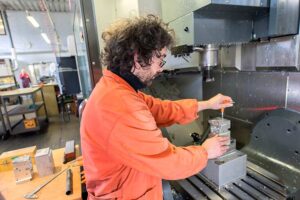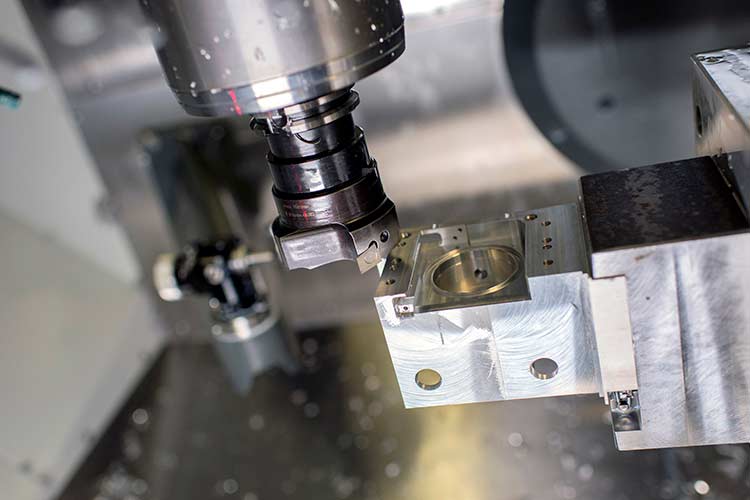In the past, five-axis machining has been cost-prohibitive for many small manufacturing businesses, leaving companies with little choice but to make complex workpieces on three- or four-axis machines, suffering the consequences of more setups, longer cycle times, and increased scrap.
Capecchi Srl of Italy is an example of how even smaller firms can now access affordable multi-axis CNC machine tools, such as the Haas UMC-750 Universal Machining Centre. The company’s new machine is making light work of complex, prismatic parts, at a unit-cost unimaginable just a few years ago.

The Capecchi Srl machine shop is located alongside the beginnings of the low Tuscan hills, just outside Florence, Italy. Visitors to this 50-year-old family owned business can read its history from a collection of example parts exhibited in two glass-fronted display cabinets in the building’s foyer. Apparently, Capecchi once made components for optical instruments, such as theodolites. Later, it designed and built its own range of optical instruments and gauges – solid looking devices with powder-coated cast-iron bases and polished machined components – that look as purposeful and well-designed now as they did half a century ago. Most European companies that once made similar products are now extinct. Capecchi has survived because it has moved with the times. The most recent parts in the cabinets are seemingly random, prismatic components of relative complexity; parts made mostly in aluminium, many with features and faces that could have only been created using a five-axis CNC machine tool.
In fact, the company’s latest investment is a Haas UMC-750, a machine that allows Capecchi to compete with far larger workshops by producing complex parts without the costs typically associated with multi-axis operations.
Today, Massimo Capecchi and his brother Andrea co-own the company that their father founded in 1962. Under the pairs’ leadership, the business has diversified, survived, and even thrived through multiple recessions and in the face of overwhelming odds.

Some of the instruments and gauges on which it made its name remain core to its business. Indeed, rail industry gauges for testing rolling stock still account for around 20 percent of turnover. The other 80 percent comprises work for sectors including laser technology, industrial automation, durometry, stereocartography and topography, through to radar, ophthalmology, and the textile and biomedical industries.
The strength of the company is its ability to provide high-quality, precision components at affordable prices with on-time delivery and a comprehensive service that includes design, prototyping, machining, inspection, and assembly.
To continue to move forward, the Capecchi brothers recently found themselves faced with the daunting prospect of investing in five-axis machining.
“It had been a few years since we’d made any serious investments,” says Massimo Capecchi. “We found ourselves looking for machines that would help to increase the productivity of the company; to make a quantum leap in terms of efficiency and quality. Many of the machines on offer were too expensive and too complex. But, we discovered in the five-axis Haas UMC-750 a machine that offered a very good relationship between quality and price. We didn’t have to look any further; our decision was made.”
Mr. Capecchi first saw the Haas machine at a trade fair before entering discussions with the local Haas Factory Outlet (HFO).

“We knew we had opted for a machine that was designed to work on a stand-alone basis, and would allow us to make parts that before we were forced to do with our three- and four-axis machines,” he says. “We can now complete more work with the Haas UMC-750, because it is better suited to the complex parts we are increasingly asked to produce.” If the Haas machine had not been available,
the Capecchi brothers would have been stretched to fund an alternative, much more expensive solution.
Batch sizes at the firm range from 5 to 200-off, although 15 to 20 is typical. For relatively low numbers, the ease and speed of set-up on the UMC-750 is vital to hitting output and productivity targets.
“The goal is to continuously improve the accuracy of what we do, and the quality of what we do,” explains Mr Capecchi, “but at the same time reducing cycle times. We are achieving this, because a five-axis machine such as the UMC-750 can approach multiple faces simultaneously, in a single setup.” This is an advantage other, bigger machine shops have been able to exploit for some time. But, five-axis technology has usually been too expensive for smaller businesses.
The Capecchi brothers say that they have enjoyed great support and assistance from Haas, both during the purchase and installation and since the UMC-750 was commissioned, in October 2014. The Haas control proved particularly easy to learn in comparison with other machines, recounts Massimo Capecchi, and in recent months the company has been busy gradually moving more and more work onto the new machine.
“For example, the workpieces currently on the machine have just been moved there,” says Mr Capecchi. “We decided to transfer these components to the UMC-750, because we can produce them so much more quickly. However, in this instance, it’s not just about cycle time, because the parts are complex, but just as much about accuracy. Fewer setups mean less opportunity to introduce inaccuracy in the finished part.” That means less scrap and more reliable deliveries, which are essential for any machining business, especially if, like Capecchi Srl, it plans to be around in another 50 years.


